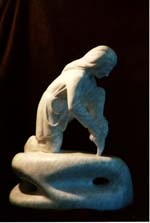 This interview was completed with Phil Montague via e-mail last month. It reveals a talented carver who is constantly expanding his knowledge and is willing to take risks to pursue his art form.
This interview was completed with Phil Montague via e-mail last month. It reveals a talented carver who is constantly expanding his knowledge and is willing to take risks to pursue his art form.
SS: When did you first develop an interest in art and sculpture, Phil?
PM: I suppose that I first became interested in creating three-dimensional forms when I was about 10, as I began building airplane models. In those olden times, models weren’t usually assembled from pre-shaped parts. Rather, they were carved from
blocks of balsa wood using an X-Acto knife. I also had a friend whose father had a wood shop with a band-saw, which I quickly came to regard as one of the world’s most important inventions. Using that wonderful tool, my friend and I would cut animal shapes from white pine, then round and smooth them with our trusty X-Acto knives and sandpaper. I sometimes wonder what led us to spend so much time sawing and carving, and I guess the answer is quite simple. There was just something enjoyable about using various tools to transform pieces of wood into shapes of our choosing.
SS: Did this lead to your interest in sculpture?
PM: My creative inclinations must have gone dormant for several years beginning in my mid-teens. I did a little wood carving while in graduate school, but didn’t become really interested again until I had taught at Western for six years or so. To a large extent, my renewed interest was sparked by my involvement in aesthetics and the philosophy or art-subjects I studied during my graduate work in philosophy and subsequently taught at Western.
Althoug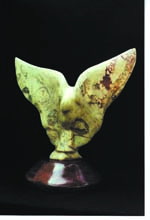 h I’m not sure I was aware of it initially, there was a kind of interplay between my carving and my thinking about the nature of art and the creative process. Shortly after I began wood carving again, I fell in love with a bronze piece I saw in a gallery in San Diego, and I decided to investigate the possibility of working in bronze. I learned about a Bellingham artist who had a small foundry who was willing to teach me the process from mold-making to applying patinas. After he left Bell-ingham, I did a few more bronze pieces in conjunction with a foundry near Chimacum. I soon realized, however, that my interest in bronze sculpture diminished significantly when I could no longer participate in the entire process.
h I’m not sure I was aware of it initially, there was a kind of interplay between my carving and my thinking about the nature of art and the creative process. Shortly after I began wood carving again, I fell in love with a bronze piece I saw in a gallery in San Diego, and I decided to investigate the possibility of working in bronze. I learned about a Bellingham artist who had a small foundry who was willing to teach me the process from mold-making to applying patinas. After he left Bell-ingham, I did a few more bronze pieces in conjunction with a foundry near Chimacum. I soon realized, however, that my interest in bronze sculpture diminished significantly when I could no longer participate in the entire process.
SS: So stone was the next step in this discovery process for you?
PM: Yes, I then discovered stone. With it I returned to the subtractive (and unforgiving) process I had applied to wood, but I quickly lost interest in working on anything but stone. Looking back, I think that I was struck by the amazing presence of stone, and by the way that it seems to occupy space more fully that other materials. In any case, it’s the only medium in which I’ve worked since that time.
SS: How did you start with stone? What did you explore first?
PM: Well, as most novice stone carvers do, I began with soapstone and then moved to alabaster, using hand tools much like those that I had used on wood. For the most part, my first pieces were bears. Their bulk and solidity is especially well-suited to stone, and I had long admired the stone bear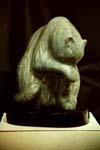 s of Inuit carvers. I knew practically nothing about stone or stone tools and, partly because I knew no other stone carvers, my learning curve was pretty shallow. Obtaining stone was a chore. Someone gave me my first piece of soapstone, and I acquired a few other pieces here and there. I heard about a large piece in the woods near Marblemount, and (much to my surprise) I found it. Using a big old (and very dull) tree saw, I spent hours cutting off a couple of pieces, and then hauled them back through the woods using a wheel- barrow. The stone turned out to be pretty bad, and I never did make anything from it.
s of Inuit carvers. I knew practically nothing about stone or stone tools and, partly because I knew no other stone carvers, my learning curve was pretty shallow. Obtaining stone was a chore. Someone gave me my first piece of soapstone, and I acquired a few other pieces here and there. I heard about a large piece in the woods near Marblemount, and (much to my surprise) I found it. Using a big old (and very dull) tree saw, I spent hours cutting off a couple of pieces, and then hauled them back through the woods using a wheel- barrow. The stone turned out to be pretty bad, and I never did make anything from it.
SS: What other sources have you found and do you use?
PM: I somehow learned about Sculpture House and ordered some Italian alabaster from them, and I also ran across a place that sold sculpturing stone while vacationing in Santa Fe. But ordering stone without seeing it had significant drawbacks, particularly given how little I knew about types and colors of stone and their characteristics.
SS: How has your association and involvement in NWSSA helped you in your pursuit of carving?
PM: Everything changed dramatically for me when I learned about and joined the NWSSA. The Association has been a terrific source of information and inspiration, and of friendship and comradery. Those of us living in Whatcom and Skagit Counties have gotten together on numerous occasions in recent years, and several in the group have worked hard-and successfully-to promote stone sculpture in the area. The most recent of these efforts is the great show curated by Jan Willing and Scott Emory that took place during November. Most important to me personally, though, has been the formation of the group studio that I share with Scott Emory, Ruth Mueseler, and Michael Jacobsen.
SS: What kind of art do you create?
PM: My pieces are small to medium-sized human or animal forms; they are representational, but with varying degrees of stylization. Although I began working with soapstone and then alabaster, during the past several years I’ve worked primarily in marble. I did a number of pieces in Carrara marble, but I’m enthralled by the colored marbles (Alaskan marbles in particular) and I’ve used them for the past year and a half or so. Switching from Carrara to colored marbles required a change in technique, moving from reliance primarily on hammer and chisels to working almost exclusively with grinders of various types. I do miss working with hand tools, though, and I particularly enjoy using hammer and chisels on Carrara marble. I’ll probably return to Carrara during the coming year.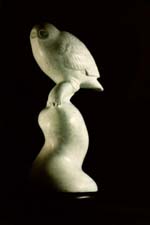
In addition to the change in tools and technique, moving from Carrara to colored marbles involved a switch from regularly to irregularly shaped stones. I was accustomed to dreaming up a design and then finding a stone to fit it. But, when I started working with irregularly shaped stones, I began to let them suggest the designs to me. Since I’m not very good at direct carving, however, I make rough clay “sketches” of the designs suggested by stones and use these as guides when working the stones. I like this method because deriving ideas from stones has a kind of liberating effect on my imagination, while using clay maquettes helps me avoid the disasters that my direct carving has produced. One thing that does remain constant though, regardless of the stone or technique I employ: my goal is to produce forms that are graceful and harmonious and, when appropriate, forms that have energy or that suggest movement. Most of my recent pieces have been birds. The stones I’ve worked on have suggested bird forms, although I suppose I might have been predisposed to finding such forms in the stones. At the moment, I’m working on two: one in Jupiter marble and one in tangerine alabaster (my first alabaster piece in quite a while).
SS: What will you be working on that we can look forward to seeing in the future?
PM: As I’m finishing the two pieces I’m working on now, I’m also considering what to do next. I have several pieces of stone that I periodically stare at while positioning and turning them in various ways, hoping that one or another will “tell” me what it should be. They’ve maintained their silence so far, so I’ll continue positioning, turning, and staring at them. These will be the next pieces that I’m looking forward to carving and I can’t wait for the stone 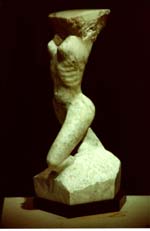 to direct me.
to direct me.
SS: What have been your satisfactions in your life as an artist?
PM: What I find most satisfying about my work is the process of coaxing pieces of stone to move in directions that are (at least to some extent) of my choosing. I haven’t been as successful at carrying out this process as I’d like to be, but I’m hoping to get better as I spend more time sculpting, and as I learn more about tools and the ways in which they interact with stones of various sorts. In this latter regard, I’m sure I’ll benefit greatly from talking with and watching the talented artists I’ve met through the NWSSA.
SS: What have been your challenges that you remember the most?
PM: My greatest challenges (and disappointments) have been associated with my attempts at creating human faces and figures. The “basics” are hard enough, not to mention the difficulties involved in capturing the subtle nuances of form or expression that human bodies and faces can exhibit.
SS: Phil, I’m curious what the future holds for you. Any plans you want to share?
PM: I’m planning to retire from teaching as of the summer of 2002, and a primary reason for doing so is that I’ll then be able to spend much more time sculpting. What I’d like to do most is work on the human face and figure, almost certainly utilizing live models in doing so. I don’t anticipate any dramatic changes in the types of pieces I create, although I suppose that such changes might occur. I’ve also thought about teaching a beginning stone sculpting class somewhere. Doing so would be a natural extension of the activity in which I’ve been engaged for most of my life and might also enable me to introduce others to the pure joy that is to be found in stone carving.

